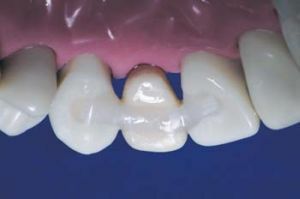 Loss of teeth as a result of their rapid wear or various dental diseases can cause serious problems. First of all, this affects the aesthetics, as well as the process of chewing and eating.
Loss of teeth as a result of their rapid wear or various dental diseases can cause serious problems. First of all, this affects the aesthetics, as well as the process of chewing and eating.
Lack of teeth also causes psychological problems during conversation and can cause numerous complexes.
In such cases it is worthwhile to think about prosthetics, for example, about the installation of adhesive bridge prostheses, which allow to completely restore the dentition and its lost functions.
Adhesive Bridge( Adhesion Bridge, Maryland, Manhattan Bridge) is a design that is used in dentistry to replace lost or worn out teeth, set without turning of adjacent teeth.
The essence of these bridges is that they are made in the form of an artificial tooth with some supports, by means of which the entire structure is fastened to two adjacent teeth and thereby the defect area is closed. The procedure for installing these structures can be performed in just one visit.
Compared to other types of prosthetic bridges, the Rochette retarder is considered to be the most gentle, because during its installation it is not necessary to install crowns.
Contents
- Features of the used adhesive
- Advantages and disadvantages - analysis without emotion
- Manufacturing process
- Special features of the
- Installation types
Adhesive
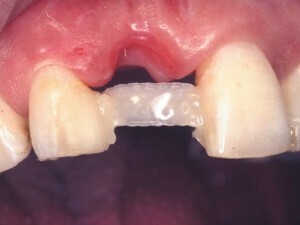
"Maryland"
During the installation of prostheses special glue, which allows you to firmly lock the device and save it for a long time. The design is installed to the tongue area of the tooth, so the bridge is not visible from the outside.
It is worth noting the important quality of the adhesive glue - since in the oral cavity there is a constant moist environment, after installing the prosthesis under the influence of saliva, the glue swells and creates adhesion between the prosthesis and the gum. This improves the fixation and retention of the prosthesis in its place.
Recently, in order to keep the Manhattan bridge firmly in place, a special beam of wire is used together with the glue. This design is fixed with a composite in the recesses that are made in the supporting teeth.
Advantages and disadvantages - analysis without emotions
The modern adhesive bridge structure has a number of positive qualities, among which are the following:
- thanks to adhesive bridges, it is possible to repair the damage of any dental units;
- , even with prolonged wearing of prostheses, there is no destruction of the teeth, which ensure the support of the entire structure;
- rapid installation, so in one procedure you can perform a complete restoration of the structure of any tooth;
- before the prosthesis is installed, the full grinding of the supporting teeth is not used( very rarely a minimal grinding without the use of depulpation);
- Maryland refers to highly aesthetic structures, in which there is no metal, thus there is no oxidation process, which adversely affects the body;
- compared to implants and structures of cermets, these prostheses belong to low-budget options.
But it's worth remembering that this kind of design has some negative qualities. So, adhesive prosthetics is considered 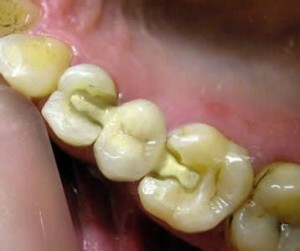 as a temporary way to restore the dentition, and at the same time able to hide only small damage. After a certain time, the bridge begins to break down, and chipped.
as a temporary way to restore the dentition, and at the same time able to hide only small damage. After a certain time, the bridge begins to break down, and chipped.
The use of Rocchett's prosthetic devices is limited, they are suitable only for those patients who want to remove injuries to the front teeth. But the design is made so that after installation it does not exert a high load on the bone. As a result, there may be a process of reduction( atrophy) of the bone. Therefore, in time, bone congestion may be required.
In addition to this, the adhesive bridge has other negative sides:
- Certain complications may occur during daily oral hygiene procedures.
- Rendering increased load on the front teeth.
- A secondary carious lesion may appear on the bridge fixation areas.
- Short service period, about 4-5 years. Many doctors give a guarantee period of three years. But the reviews of many patients confirm that if the product is treated with care, then the adhesive bridge prosthesis can serve much more.
- During the whole period of wearing it is required to strictly follow all the recommendations of the attending physician. It is necessary to adhere to a special food at which it is necessary to refuse the use of food with the raised rigidity. It is also worth regular cleaning of the oral cavity with the use of rinsers and dental floss.
The process of manufacturing
During the first appointment, the doctor should carefully examine the oral cavity of the patient, and also take note of the clinical indications for the installation of the prosthetic design.
Next, choose the color, shape of the structure, and indicate the degree of its transparency. Then a cast of teeth is made.
After this, the patient should wait until the prosthesis is made in the laboratory.
Various types of technologies are used for the production of an adhesive-bridged prosthesis:
- Clinical method .In this case, the prosthetic element is formed directly in the oral cavity of the patient.
- Laboratory method .During the first visit to the clinic by the patient, the doctor removes the impression from the relevant area. It may take some time to manufacture the product with this method, but the result is a more robust construction that will allow effective restoration of lost teeth. The manufacturing of a bridge using this technology is applied when ceramic or plastic is used as a material.
- Combined method .Prosthetics using this method is applied only at the discretion of the dentist. In this case, a connection is made between two methods - direct and laboratory.
Features of the
installation The installation process is carried out for several visits, and the production of adhesive bridges is performed in several stages.
Features of the Maryland installation:
- At the initial stage, preparation of supporting teeth is carried out. Small incisions are made from the side parts. If suddenly the
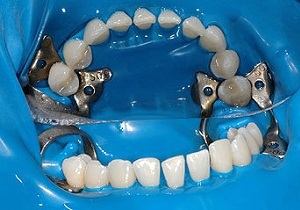 dentist deems necessary, then the depulping and filling of the channels is performed additionally( it is rarely performed, only in case of emergency).After this, the cofferdam is installed, which is fixed by means of special tongs. These are special plates, by means of which the supporting teeth are separated from the other incisors.
dentist deems necessary, then the depulping and filling of the channels is performed additionally( it is rarely performed, only in case of emergency).After this, the cofferdam is installed, which is fixed by means of special tongs. These are special plates, by means of which the supporting teeth are separated from the other incisors. - The length of the beam is then determined, foil is used for this.
- At the next stage, the reinforcement is installed, it can be on fiberglass or on pins. Empty cavities between threads are filled with a special tool.
- Then orthophosphoric acid is applied to the support.
- The pins are being installed and a base for the prosthesis is made.
- At the next stage of the installation process, the matrix is prepared from a brass base. This construction should have an increased degree of rigidity and be rounded. It is attached firmly to the gum area. For fastening, wedges or adhesives are used, which do not cause allergies.
- After completing all the preparatory measures, the doctor starts the process of building up the dental unit. Glass fiber is used as a basis. The creation of the prosthesis is performed according to the peculiarities of the structure of the jaw, peculiarities of the occlusion.
- Next, procedures are performed that are aimed at restoring the support. During these procedures, layers of dentin and enamel are applied.
- At the end of the procedure, the adhesive prosthesis is polished.
Installation process visually:
Types of
mounts Installation can be performed in three ways:
- Fastening on beams .This type of attachment is used to improve the stability of the structure. The beam is made of wire, it is fixed using a special composite.
- Shielding .During this fixing method, a special fiberglass warp tape is used. It is convenient
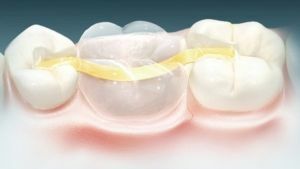
The splinting for the
bridge is placed in the area of the supporting teeth. In order to ensure reliable fastening, you only need to correctly apply the tape.
- Application of construction without turning .During this fixing method, the support is processed and the prosthesis is secured to the sides. Also, adhesives can be used for fixing. For this, fiberglass or plastic strips are glued on the back side, which will then hold the entire dentition.
Features of the
care After installing the adhesive bridge, it is important to observe the proper care, this will allow to keep the device permanently in perfect order. This will help the following recommendations:
- regular oral hygiene;
- cleaning of teeth and prosthesis with a brush with soft bristles and toothpaste;
- mouth rinsing after each meal;
- when cleaning teeth it is worth using a special dental floss, with which you can remove food debris even from hard-to-reach places.
There is an opinion
Adhesive denture is gaining increasing popularity, which is confirmed by numerous reviews of patients.
After I found out about the Rochette's retina, I immediately decided to install them. It's good that I went to a private dental clinic, which has many positive reviews and not undermined reputation.
There I had a thorough examination, the procedure for manufacturing and installing the prosthesis was performed by doctors with extensive experience, so I fully trusted them. In addition, I did not even have a dentition. After the procedure, I saw that all the teeth were in place, while I did not notice any difference between artificial and real teeth.
Alexandra, 48 years old
I decided to use adhesion bridges because they have low cost, and after installation, the results are no worse than when installing expensive implants. Of course, this process is quite long, but it's worth it.
Now I can normally eat, talk, smile, and all thanks to this bridge!
Nadezhda, 42
Photo-selection of patients before and after the adhesive bridge was installed:
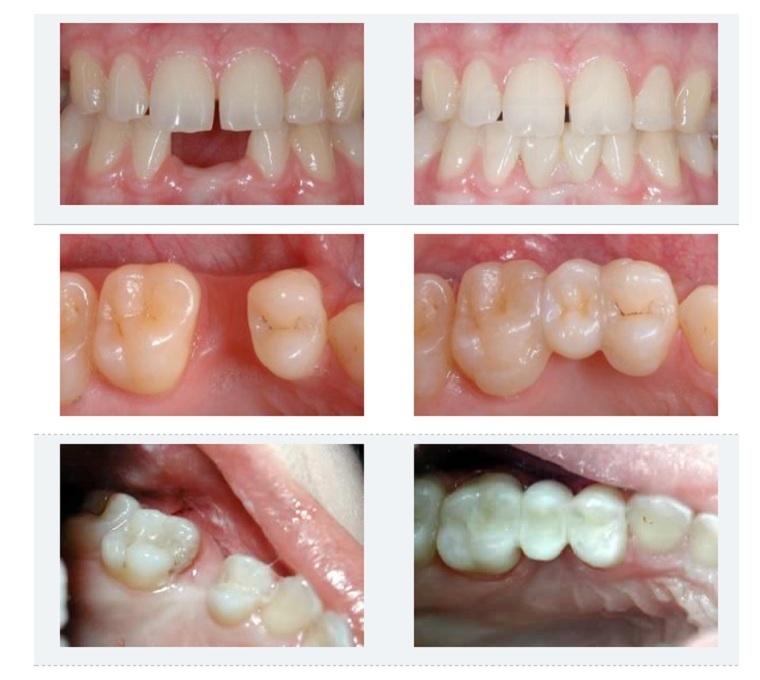

Price
Price depends on many factors - from the clinic, on the type of attachment, on the material, on the complexity of the installation, so the cheapest are considered adhesivebridges from plastic, their cost is about 1000 rubles, but the construction of chromium and cobalt already cost from 3 000 to 4 000 rubles, cermets cost an average of 5 000-6 000 rubles.
